- Badallan pit
- Badallan No.2 mine
- Balbardie - old pits
- Balbardie No.1 pit
- Balbardie No.2 pit
- Balbardie No.2 mine
- Balbardie No.4 pit
- Balbardie No.5 pit
- Ballencreiff fireclay mine
- Ballencrieff - early pits
- Barbauchlaw - early pits
- Barbauchlaw No.1 pit
- Barbauchlaw No.2 pit
- Barbauchlaw No.3 pit
- Barbauchlaw No.4 pit
- Barbauchlaw No.5 pit
- Barbauchlaw No.7 pit
- Barbauchlaw No.9 pit
- Barbauchlaw No.11 pit
- Barbauchlaw No.10 pit
- Barbauchlaw No.12 pit
- Barbauchlaw No.13 pit
- Barbauchlaw No.14 pit
- Barbauchlaw No.15 pit
- Barbauchlaw No.16 pit
- Barbauchlaw No.17 pit
- Barbauchlaw No.18 pit
- Barbauchlaw No.19 pit
- Barbauchlaw No.23 pit
- Barbauchlaw Fireclay and Coal Mine
- Bathgate - old pits
- Bathville No.1 pit
- Bathville No.3 pit
- Bathville No.4 pit
- Bathville No.5 pit
- Bathville unidentified pit 1
- Bathville unidentified pit 2
- Bathville unidentified pit 3
- Benhar (Addie) No.2 pit
- Benhar No.6 and No.14 pits
- Benhar Colliery
- Benhar No.18 pit
- Benhar No.19 pit
- Benhar No.21 pit
- Benhar No.3 pit
- Benhar No.5 pit
- Benhar - old pits
- Benhar unidentified pits
- Benthead No.1 mine
- Benthead unidentified pit 1
- Benthead unidentified pit 2
- Benthead unidentified pit 3
- Benthead unidentified pit 4
- Benthead unidentified pit 5
- Benthead unidentified pit 6
- Bents mine
- Birniehill mine
- Blackrigg No. 1 & 2
- Blackrigg No.3 pit
- Boghead No.1 pit
- Boghead No.2 pit
- Boghead No.3 pit
- Boghead No.4 pit
- Boghead No.5 pit
- Boghead No.6 pit
- Boghead No.8 pit
- Boghead No.9 pit
- Boghead No.10 pit
- Boghead No.11 pit
- Boghead No.12 pit
- Boghead No.14 pit
- Boghead No.15 pit
- Boghead No.25 mine
- Braehead No. 1 pit
- Braehead No.2 pit
- Bridgecastle - early pits
- Bridgehouse - old pits
- Bridgehouse pit
- Brucefield pit
- Camps pit
- Cappers No.1 pit
- Cappers No.2 pit
- Cappers No.3 pit
- Cappers No.4 pit ?
- Colinshiel No.1 pit
- Colinshiel No.2 pit
- Colinshiel No.3 pit
- Colinshiel No.4 pit
- Cowdenhill No.1 Pit
- Craigrigg pit
- Crofthead (Stonehead) No.1 pit
- Crofthead No.2 pit
- Crofthead No.3 pit
- Crofthead No.5 & 6 pit
- Crofthead No.7 pit
- Crofthead (Stonehead) No.7 pit
- Cult pit
- Cultrigg No.1 & No.2 pits
- Cultrigg No.3 pit
- Cultrigg No.4 pit
- Cuthill mines
- Drumcross pits
- Drum No.1 & 2 pits
- Dumback No.1 mine
- Dumback No.2 mine
- East Benhar No.2 mine
- Eastfield No.1 ironstone pit
- Eastfield No.3 ironstone pit
- Eastfield No.3 coal pit
- Eastfield No.4 ironstone pit
- Eastfield No.5 pit
- Eastfield No.6 pit
- Eastfield No.8 ironstone pit
- Eastfield Eagin pit
- Eastfield Engine pit
- Eastfield unidentified pit 1
- East Handaxwood fireclay mine
- Easton No.1 pit
- Eastrigg (Craigrigg) No.1 pit
- Eastrigg (Craigrigg) No.2 pit
- Eastrigg (Craigrigg) No.3 pit
- Fallahill No.3 pit
- Fallahill No.4 pit
- Fauldhouse No.1 pit
- Fauldhouse No.1 (Knowes) pit
- Fauldhouse No.5 pit
- Fauldhouse No.8 pit
- Fauldhouse No.9 pit
- Fauldhouse No.10 pit
- Fauldhouse No.11 pit
- Fauldhouse No.13 pit
- Foulshiels No.1 & No.2 pits
- Gormyre mine
- Goukstane pit
- Greenburn pit
- Greenrigg pit
- Handaxwood No.1 pit
- Handaxwood No.2 pit
- Handaxwood No.3 pit
- Handaxwood No.4 pit
- Handaxwood No.5 pit
- Handaxwood early pits
- Handaxwood unidentified pit 1
- Handaxwood unidentified pit 2
- Handaxwood unidentified pit 3
- Handaxwood unidentified pit 4
- Handaxwood unidentified pit 5
- Handaxwood unidentified pit 6
- Handaxwood unidentified pit 7
- Handaxwood unidentified pit 8
- Handaxwood unidentified pit 12
- Handaxwood unidentified pit 13
- Handaxwood unidentified pit 14
- Handaxwood unidentified pit 15
- Harburn limestone mine
- Harthill No.1 ironstone pit
- Hartrigg or Harthill No.3
- Hartrigg No. 4 & 5 pit
- Heads mine
- Heatherfield No.4 pit
- Heatherfield No.5 pit
- Heatherfield No.6 pit
- Heatherfield No.7 pit
- Hilderston Hill pit
- Hilderston - early pits
- Hopetoun No.2 pit
- Heatherfield No.3 pit
- Hopetoun No.8 pit
- Hopetoun No.9 pit
- Hopetoun No.10 pit
- Hopetoun No.11 pit
- Hopetoun No.12 & 13 pits
- Inchcross No.1 pit
- Inchcross No.2 pit
- Kipps - early pits
- Knowton No.1 & 2 pits
- Latchburn pit
- Leadloch No.1 pit
- Leadloch No.2 pit
- Levenseat No.1 limestone pit
- Levenseat No.2 pit
- Levenseat No.3 limestone pit
- Levenseat No.3 fireclay mine
- Levenseat No.4 fireclay mine
- Levenseat No.1 & 2 fireclay mine
- Levenseat High mine
- Levenseat No.1 limestone mine
- Levenseat quarry limestone mines
- Levenseat unidentified mine
- Loganlea No.1 pit
- Loganlea No.2 pit
- Longford pit
- Mosside No.1 Pit
- Mosside No.2 pit
- Mosside No.3 pit
- Mosside No.4 mine
- Muckraw mine
- Muirhousedyke pit (1)
- Muirhousedyke pit (2)
- Muldron No.6 pit
- Muldron No.7 pit
- Muldron No.8 pit
- Muldron No.9 pit
- Muldron unidentified pit 1
- Muldron unidentified pit 2
- Muldron unidentified pit 3
- Muldron unidentified pit 4
- Muldron unidentified pit 5
- Muldron unidentified pit 6
- Muldron unidentified pit 7
- Muldron unidentified pit 8
- Muldron unidentified pit 9
- Muldron unidentified pit 11
- Muldron unidentified pit 10
- Muldron unidentified pit 12
- Murieston Limestone Mine
- Murraysgate mine
- North Cobbinshaw coal mine
- Northrigg No.2 pit
- Northrigg No.7 pit
- Northrigg No.1 mine
- Northrigg No.2 mine
- Polkemmet No.5 pit
- Polkemmet No.6 pit
- Polkemmet No.8 pit
- Polkemmet No.9 pit
- Polkemmet Colliery
- Polkemmet No.3 pit
- Polkemmet unidentified pit 1
- Polkemmet unidentified pit 2
- Polkemmet unidentified pit 3
- Polkemmet unidentified pit 4
- Pottishaw No.1 & 2 mine
- Redhouse pit
- Riddochhill No.1 pit
- Riddochhill No.2 pit
- Riddochhill Almond Mines
- Snab pit
- South Broadrigg pit
- Southrigg No. 1 & 2 pits
- Southrigg No. 3 & 4 pits
- Southrigg No. 7 & 8 pits
- Standhill No.1 pit
- Standhill No.2 pit
- Starryshaw No.1 & 2 pits
- Stonehead mine
- Stonehead No.1 pit
- Stonehead No.2 pit
- Stoneheap limestone pit
- Stoneyburn No.1 pit
- Stoneyburn No.2 pit
- Tippethill No.1 & 2 mine
- Torbane No.1 pit
- Torbane No.2 pit
- Torbane No.3 pit
- Torbanehill No.1 pit
- Torbanehill No.2 pit
- Torbanehill No.3 pit
- Torbanehill No.4 pit
- Torbanehill No.5 pit
- Torbanehill No.6 pit
- Torbanehill No.7 pit
- Torbanehill No.8 pit
- Torbanehill No. 9 pit
- Torbanehill No.10 pit
- Torbanehill No.11 pit
- Torbanehill No.12 pit
- Torbanehill No.13 pit
- Torbanehill No.14 pit
- Torbanehill No.15 pit
- Torbanehill No.16 pit
- Torbanehill No.17 pit
- Torbanehill No.18 pit
- Torbanehill No.19 pit
- Torbanehill No.20 pit
- Torbanehill No.21 pit
- Torbanehill No.24 pit
- Torbanehill No.26 pit
- Torbanehill No.29 pit
- Torbanehill Garden Pit
- Trees No.1 pit
- Trees No.2 pit
- Trees No.3 pit
- Wallhouse No.1 mine
- Westallan pit
- Westfield No.1 pit
- Westrigg No.1 pit
- Westrigg No. 2 & 3 pit
- Whitrigg No. 1 & 2 pits
- Whitrigg No. 4 Burnbrae mine
- Whitrigg No. 5 pit
- Whitrigg No.8 & 9 mine
- Woodbank Mine
- Woodend No.1 pit
- Woodend No.2 pit
- Woodend No.3 pit
- Woodend No.4 pit
- Woodend No.5 pit
- Woodmuir No.1 pit
- Woodmuir No.2 pit
- Woodmuir No.3 pit
- Woodmuir No.4 pit
- Woodmuir - early pits (south)
- Woodmuir - early pits (north)
Benhar Colliery
A group of early coal pits in the land of Polkemmet.
"A Coal Pit out of which is taken common Coal, it is worked by a Steam Engine of 7 horse power; being 8 fathoms in depth, and the thickness of Seam 15 inches: leased and worked by Mr Simpson of Monkland and the property of the Trustees of the late Mr Philip Russell Fauldhouse."
OS Name Book OS1/34/66/12 c.1852
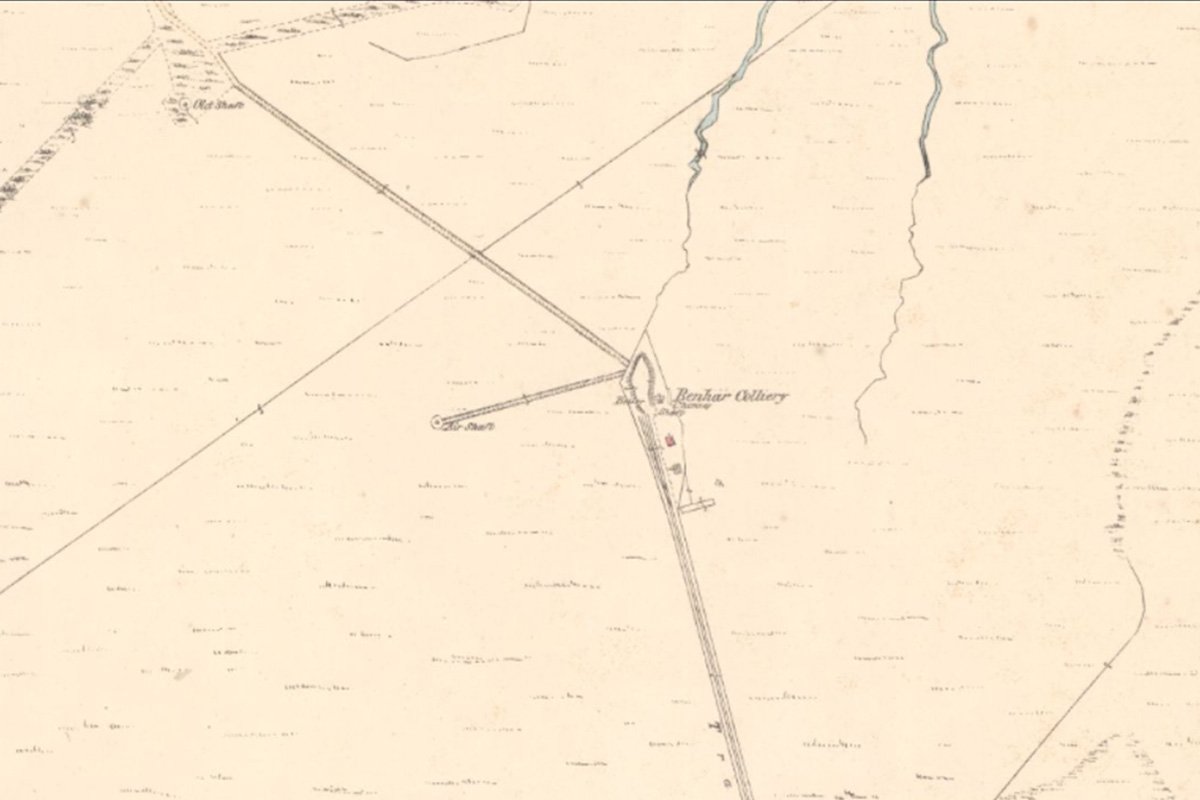
25" OS map c.1855 courtesy National Library of Scotland
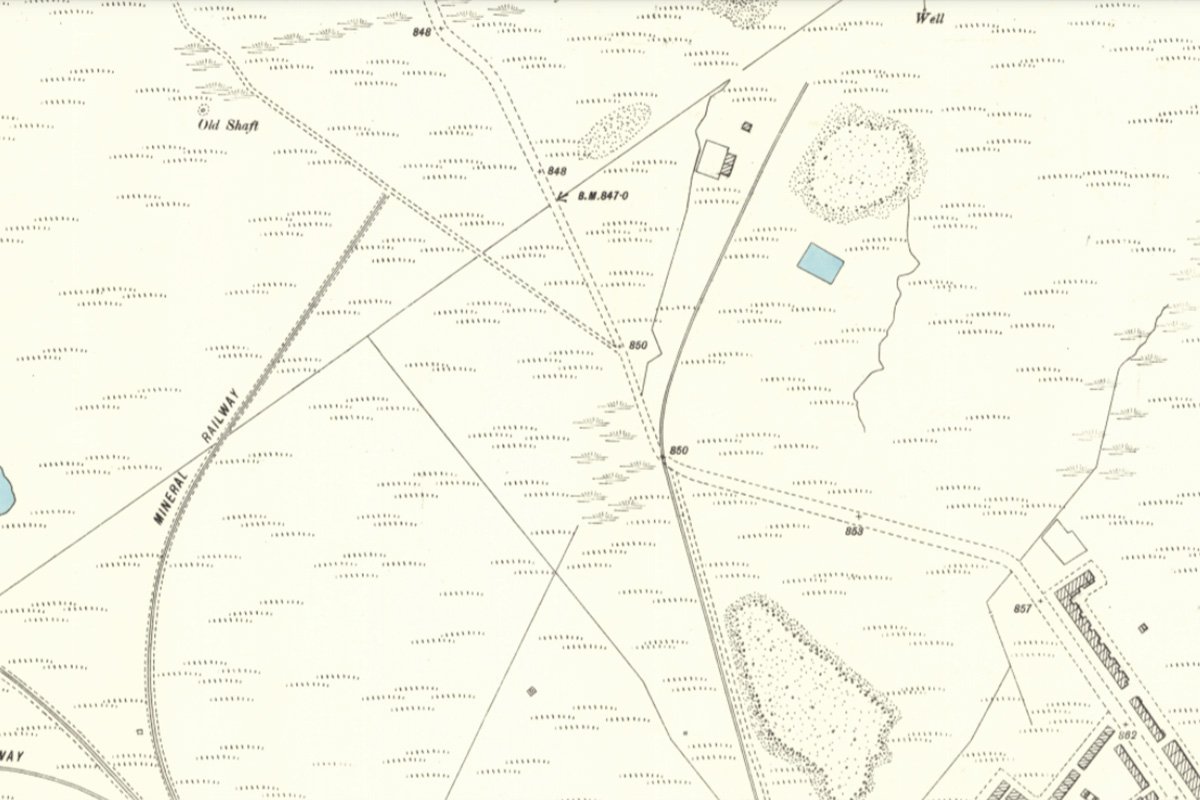
25" OS map c.1895 courtesy National Library of Scotland
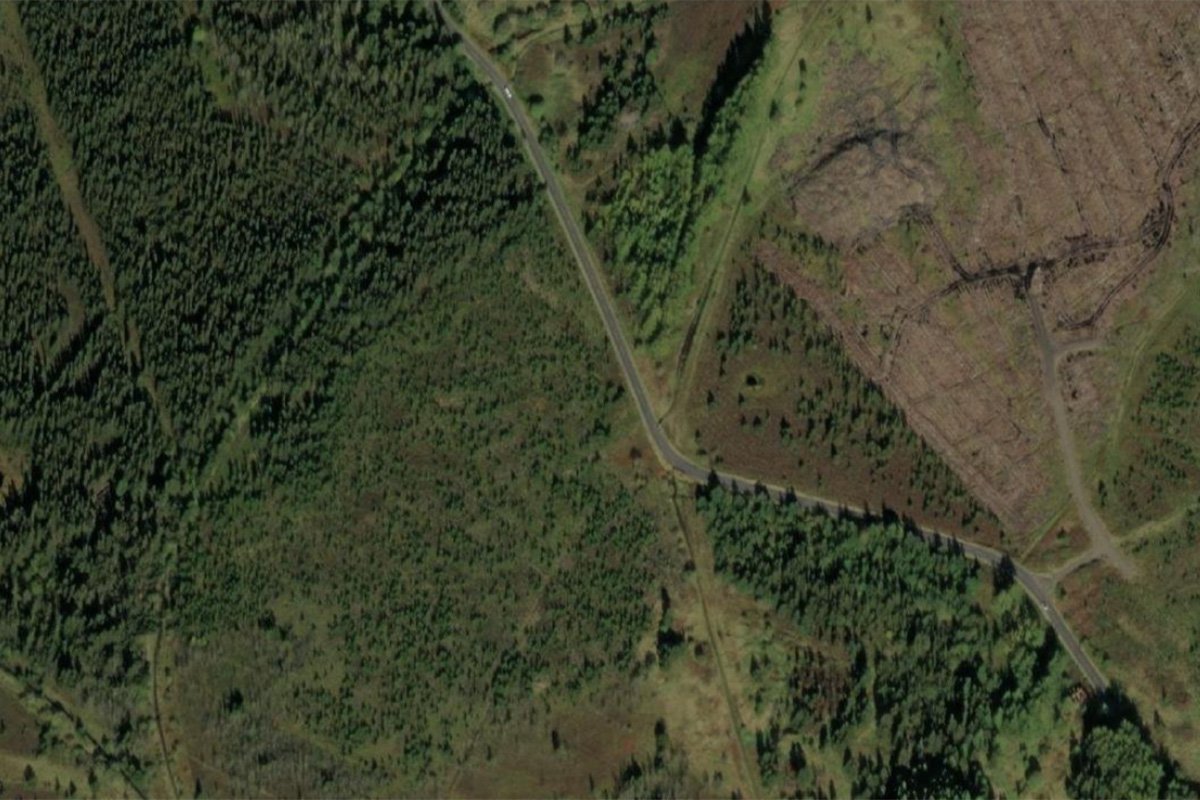
aerial view

lidar view
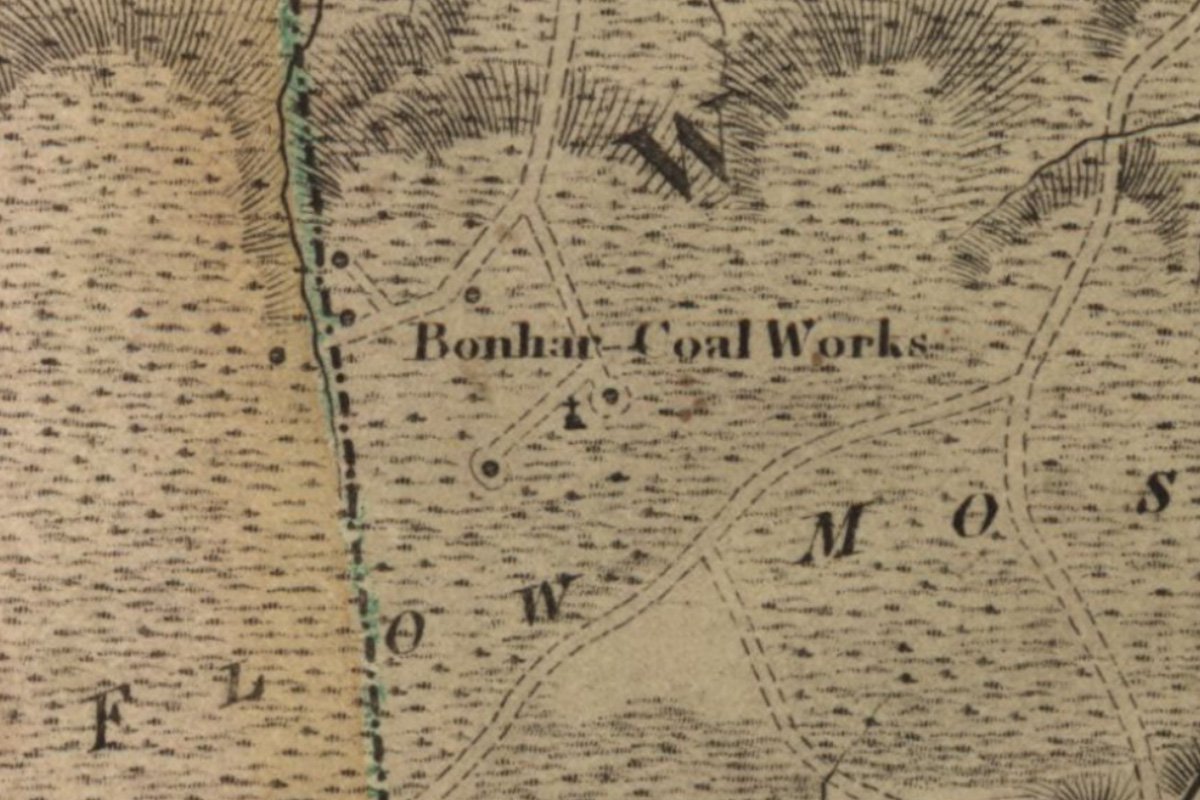
William Forrest, Map of Linlithgowshire, 1818, courtesy National Library of Scotland
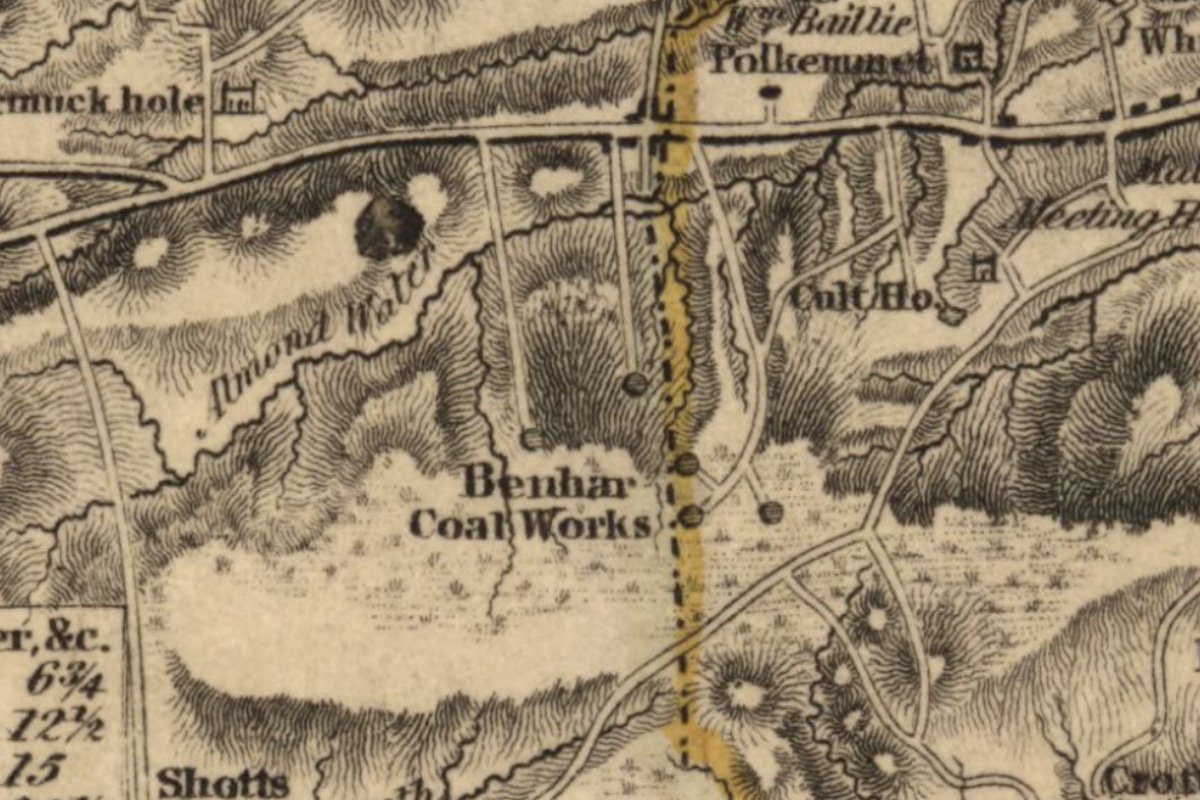
James Knox, Map of the Basin of the Forth, 1826, courtesy National Library of Scotland
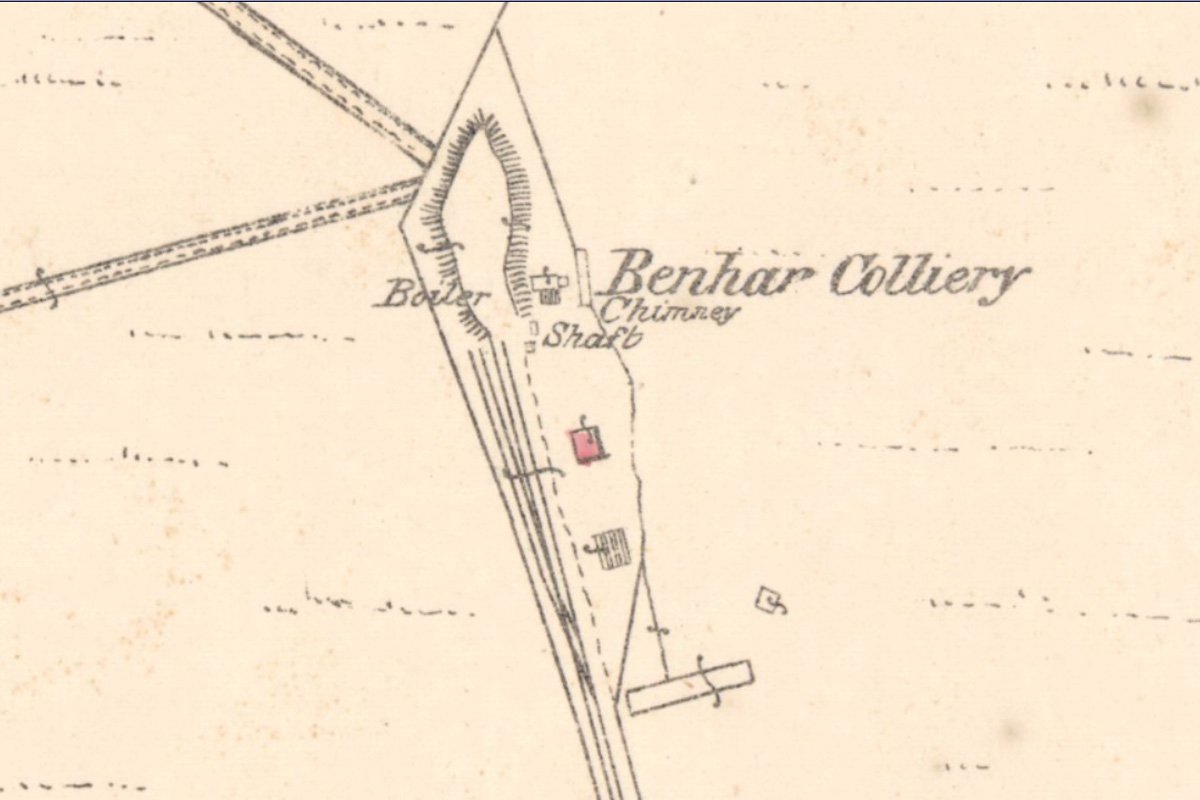
25" OS map c.1855 courtesy National Library of Scotland
References
LINLITHGOWSHIRE ROADS BILL. The Committee resumed the inquiry upon this bill on Tuesday. The examination of Mr. Chalmers was proeeeded with The witness stated that the bill proposed to divide the county into districts, which were not defined, and he believed that the settlement of their division would cause great difference in the county. …...
Mr George Simpson stated that he was the lessee of the Benhar Colliery, in the parish of Whitburn, from which he raised 70,000 tons annually. The Coal was sent by private railroad to the public railway, and did not pass along the road. He believed that if he were assessed upon the number of horses employed, he would contribute a sum fully adequate to the use he made of the road. Cross-examined—He kept two horses present. It was usual for mineral owners to hire horses.
Falkirk Herald, 8th June 1865
.......
Railway Accident. On Saturday, an accident occurred the Benhar Colliery branch of the North British Railway, whereby 13 coal waggons, partly the property the coalmasters and the railway company, were almost totally destroyed. The Benhar Colliery branch was constructed some years ago by Mr Simpson of Benhar. but has since been purchased the North British Railway Company, and to save expenditure, no doubt, was made as short possible. The ground upon which it is formed, forms the ridge of hilly ground, and at one part of the line the gradient is about 1 in 15. The traffic is worked by tank locomotives, and the load is regulated to the peculiar nature of the gradients, the engines not being allowed to take more than 8 full waggons down a time with iron snibbles put into the wheels of several of them, to assist in retarding their motion. On Saturday, it appears, 15 large waggons, containing coal, were brought to the top the incline, and the guard having put in one of the snibbles, and supposing the wuggons would not run further, went with the engine which takes in water at pit the side the branch. Gradually, however. the weight of the train overcame the resistance presented by the snibbled waggon, and gaining momentum, dashed headlong at fearful rate to the bottom of the incline. The consequence was that 13 of the waggons were smashed, being literally piled one over the other. On Sunday, a large staff of men with sufficient engine power, was brought from Morningside for the purpose of clearing away the wreck, and we learn that six or seven of the waggons are beyond repair. The damage will exceed £400
Hamilton Advertiser, 11th April 1868

